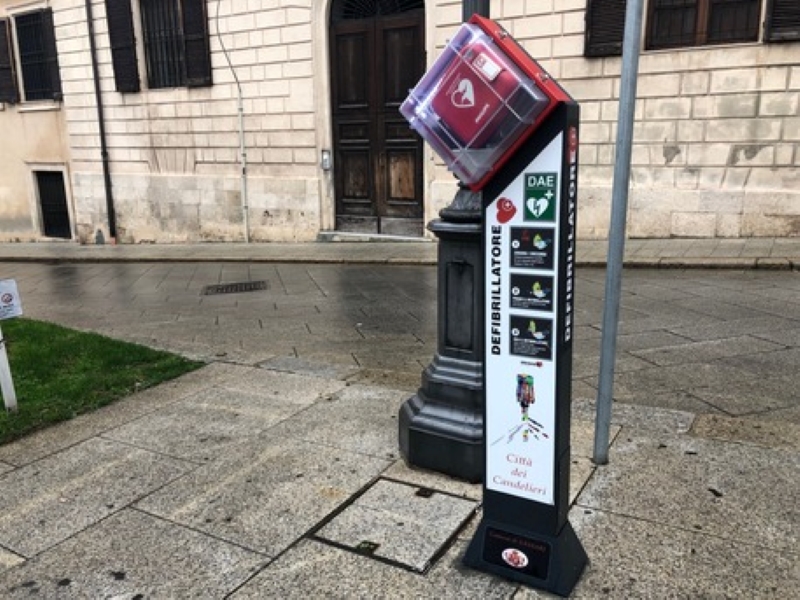
Notions of First Aid: what a defibrillator is and how it works
What is an AED defibrillator and how it works: everything you need to know about this life-saving device
Health and safety are topics of paramount importance, especially when it comes to emergency situations such as cardiac arrest.
In this article, we will try to understand together what a defibrillator is, how it works and how it can be used to save lives in case of need.
What is a defibrillator?
A defibrillator is used to treat sudden cardiac arrest, a potentially fatal condition in which the heart suddenly stops beating.
The defibrillator delivers an electrical impulse to the heart, helping to restore normal heart rhythm and prevent death.
With AED defibrillators, it is literally impossible to deliver a shock to a heart that is not in cardiac arrest, as the defibrillator only delivers a shock if the heart rhythm analysis detects a shockable rhythm.
If the heart beats normally, the defibrillator will simply not allow a shock.
Even if an attempt is made to press the shock button or someone accidentally presses the shock button, a shock will not be delivered to the patient.
There are two main types of external defibrillators, both identified by the acronym AED: semi-automatic external defibrillators and automatic external defibrillators.
These two devices differ in the moment at which the shock is delivered:
- With the semi-automatic external defibrillator, it must be the rescuer who manually initiates the shock by pressing the button.
- The automatic external defibrillator only needs to be switched on and connected to the patient. Once the state of cardio-circulatory arrest has been ascertained, the device proceeds to deliver the electrical discharge autonomously, without any external human intervention. The operator intervention required with an automatic defibrillator is even less than with a semi-automatic defibrillator, reducing even more the possibility of mistakes.
How does a defibrillator work?
We have understood what a defibrillator is and the difference between a semi-automatic and automatic defibrillator, but how do you use a defibrillator?
Once you have recognised the cardiac arrest and alerted the emergency services, it is essential to begin cardiopulmonary resuscitation (CPR) manoeuvres immediately and try to find a defibrillator as quickly as possible.
- Press the power button: carefully follow the voice or visual instructions provided by the device
- Withdraw the paddles
- Prepare the patient: Uncover the patient’s chest, clean and dry the skin if necessary.
- Place the pads: Apply the adhesive pads to the patient’s chest as shown in the figure. One plate should be placed under the right clavicle and the other under the left armpit. Ensure that the plates adhere to the skin.
- Heart rhythm analysis: Once the pads are connected, the defibrillator automatically analyses the patient’s heart rhythm. At this stage the AED will warn that no one should touch the patient.
- Delivering the shock: If the defibrillator determines that it is necessary to deliver a shock, you will need to press the ‘shock’ button, after ensuring that no one is touching the patient. For automatic defibrillators, the shock will be delivered automatically.
- Resume cardiopulmonary resuscitation (CPR) manoeuvres: The AED will inform us when the discharge has been delivered and indicate whether it is necessary to resume CPR.
- Patient monitoring: In case the defibrillator does not indicate the delivery of the discharge, follow the visual or acoustic cues and continue with CPR. The defibrillator will continue to monitor the patient’s heart rhythm and provide further instructions if necessary.
BLSD training
Although AED defibrillators are designed to be used even by people without any training, it is advisable to attend a BLSD (Basic Life Support and Defibrillation) training course.
These courses provide detailed information on how to recognise a cardiac arrest, how to perform resuscitation manoeuvres and how to use a defibrillator correctly.
Training can help save lives and increase confidence in using a defibrillator in an emergency.
But if you happen to witness an emergency before deciding to attend a course, remember to take action: while waiting for the rescuers, your intervention will probably save a life.
Read Also
Emergency Live Even More…Live: Download The New Free App Of Your Newspaper For IOS And Android
All You Need To Know About Automated CPR Machine: Cardiopulmonary Resuscitator / Chest Compressor
Defibrillator Maintenance: What To Do To Comply
Defibrillators: What Is The Right Position For AED Pads?
When To Use The Defibrillator? Let’s Discover The Shockable Rhythms
Who Can Use The Defibrillator? Some Information For Citizens
Defibrillator Maintenance: AED And Functional Verification
Diseases Of The Valves Of The Heart: Aortic Stenosis
What Is The Difference Between Pacemaker And Subcutaneous Defibrillator?
What Is An Implantable Defibrillator (ICD)?
What Is A Cardioverter? Implantable Defibrillator Overview
Paediatric Pacemaker: Functions And Peculiarities
Cardiac Arrest: Why Is Airway Management Important During CPR?
RSV (Respiratory Syncytial Virus) Surge Serves As Reminder For Proper Airway Management In Children
Supplemental Oxygen: Cylinders And Ventilation Supports In The USA
Heart Disease: What Is Cardiomyopathy?
Inflammations Of The Heart: Myocarditis, Infective Endocarditis And Pericarditis
Heart Murmurs: What It Is And When To Be Concerned
Broken Heart Syndrome Is On The Rise: We Know Takotsubo Cardiomyopathy
Cardiomyopathies: What They Are And What Are The Treatments
Alcoholic And Arrhythmogenic Right Ventricular Cardiomyopathy
Difference Between Spontaneous, Electrical And Pharmacological Cardioversion
What Is Takotsubo Cardiomyopathy (Broken Heart Syndrome)?
Dilated Cardiomyopathy: What It Is, What Causes It And How It Is Treated
Heart Pacemaker: How Does It Work?
Italy, ‘Good Samaritan Law’ Approved: ‘Non-Punishability’ For Anyone Using A Defibrillator AED
Oxygen Damaging For Heart Attack Patients, Study Says
European Resuscitation Council (ERC), The 2021 Guidelines: BLS – Basic Life Support
Paediatric Implantable Cardioverter Defibrillator (ICD): What Differences And Peculiarities?


